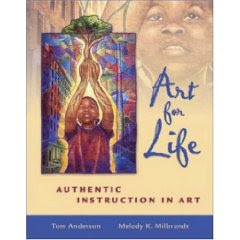Joni Hough
February 19, 2010
ARTE 5122
Art Issue Paper
In art, traditional is non-Western and modern is Western. It is as simple as that! Or is it? Like most things, it is not that simple. Western and non-Western cultures have greatly influenced each other. Also, there are serious implications for art education when non-Western art is assumed to be traditional and Western art is assumed to be modern.
Defining “non-Western” is just as complicated. The term “non-Western” is biased by its very nature, because it refers to a large part of the world by what it is not, rather than what is. Synonyms used for non-Western, including, “preindustrial societies” (Congdon 1989, p. 180), “the Third World” (Minor 2001, p. 207), “the East” (Minor 2001, p. 207) and “traditional societies” (Strother 1995), are no less problematic. These terms are largely prejudicial and/or inaccurate in their descriptions. The regions generally associated with the non-West include Asia, Africa, India, Latin America, and the Middle East (Osborn 2009). Not only are these vastly different regions with their own cultures, but as with the countries in the West, they are not all even in the Eastern Hemisphere. These terms are insufficient, and educators need to use more precise language when referring to any part of the world.
Tradition, as defined by Delahunt (n.d.), “is the passing along of a culture from generation to generation, especially orally.” This method of socialization is not exclusive to either the West or the non-West. Some of the synonyms used to describe traditional art include primitive art, folk art, ethnic art, and indigenous art (Delahunt n.d.). These terms carry with them a connotation that traditional art is lesser than nontraditional art. According to Blocker (2001), traditional art is that which is produced by people who are not European or American. By this definition, non-Western art (and some Western art) is automatically traditional, simply by means of who made the art. This definition does not take into account the type of art, its purpose, or its context.
Gablik (1984) describes modernism as, “the term that has been used to describe the art and culture of the past hundred years” (p. 11). In Gablik’s definition there is no distinction made as to whether the art or culture of the past hundred years is Western or non-Western. This lack of distinction could be because Gablik believes that modernism is universal or it could be ethnocentrism, were Gablik is simply omitting then art and culture of the non-West. Blocker (2001) on the other hand, refers to modernism as the period, “in Europe roughly from the end of the seventeenth century through the early decades of the twentieth century” (p. 8). By this account, modernism is exclusively a Western phenomenon. According to Gablik (1984), Blocker (2001), and Minor (2001), the key idea of modernism is art for art’s sake. Blocker (2001) further states that the “ideas of ‘aesthetic enjoyment’ and ‘fine art’ and ‘artist’ were socially constructed and culturally inculcated in what we call the ‘modern’ period” (p. 8).

The idea that traditional art is non-Western and modern art is Western is not at all simple or accurate. This statement ignores the many artists in the West that do not prescribe to modernist notion of “art for art’s sake.” For example, African American artists, such as Jacob Lawrence and Faith Ringgold, whose works have highlighted social issues. Lawrence created a series of work that focused on the occupations available to African Americans in 1940’s Harlem. Ringgold’s triptych, Street Story Quilt, also set in Harlem, is a story of survival and redemption.
There are also examples of non-Western artists who have created modern art. For example, Indian artist, Natvar Bhavsar, whose formalist work deals with the color, yellow. Chilean artist, Matta’s (Roberto Matta Echaurren) Being With (Être Avec), is a massive surrealistic painting, which is a subgenre of modernism. Another non-Western modern artist is Israeli sculpture, Yaacov Agam. His 1966 piece, Relief Rhythm, is abstract geometric forms created from painted wood.
 The statement, traditional art is non-Western and modern art is Western, also does not take into account the hybridization of the West and the non-West that has come from globalization. Artist Yinka Shonibare MBE, for instance, was born in England to Nigerian parents. He grew up traveling between Lagos, Nigeria and London, England and his work deals with cultural identity (Art: 21 n.d.). African American artist, Elizabeth Catlett is another multicultural artist. Catlett began her career in the United States, but in 1946 she moved to Mexico, where she continues to live. She joined the Taller de Gráfica Popular, a printmaking workshop in Mexico City. Her work combines the printmaking she studied in Mexico with archetypal African American women, such as in her lithograph, Mother and Child (Metropolitan Museum of Art n.d.). Biracial artist, John Feodorov is of Navajo and European American decent. He grew up in the Suburbs of Los Angeles and on a Navajo reservation. Feodorov’s work comically confronts Native American stereotypes, as in his mixed-media sculpture, Animal Spirit Channeling Device for the Contemporary Shaman (Art: 21 n.d.).
The statement, traditional art is non-Western and modern art is Western, also does not take into account the hybridization of the West and the non-West that has come from globalization. Artist Yinka Shonibare MBE, for instance, was born in England to Nigerian parents. He grew up traveling between Lagos, Nigeria and London, England and his work deals with cultural identity (Art: 21 n.d.). African American artist, Elizabeth Catlett is another multicultural artist. Catlett began her career in the United States, but in 1946 she moved to Mexico, where she continues to live. She joined the Taller de Gráfica Popular, a printmaking workshop in Mexico City. Her work combines the printmaking she studied in Mexico with archetypal African American women, such as in her lithograph, Mother and Child (Metropolitan Museum of Art n.d.). Biracial artist, John Feodorov is of Navajo and European American decent. He grew up in the Suburbs of Los Angeles and on a Navajo reservation. Feodorov’s work comically confronts Native American stereotypes, as in his mixed-media sculpture, Animal Spirit Channeling Device for the Contemporary Shaman (Art: 21 n.d.).Modern art can not exist without the influence of traditional arts. As modern artists try to produce something more unique and unusual, they find that, “to be modern now is to be traditional.” Additionally, “Artists are finding that the only way to make something new is to borrow from the past.” (Gablik 1984, p. 117). This is true with many fiber artists, who utilize art techniques and media that often derives from the traditions of women’s domestic arts or folk art. For instance, Miriam Schapiro’s The Poet #2, uses fabric and quilt blocks (University Art Museum, University at Albany SUNY n.d.).
Pablo Picasso was influenced by the traditional Africa masks and Paul Gauguin drew inspiration from traditional Tahitian sculpture (Museum of Modern Art n.d.). This can be seen in Picasso’s Les Demoiselles d'Avignon and in Gauguin’s Te Atua (The Gods) from Noa Noa (Fragrance.)
Traditional influences can also be seen in many forms of architecture. For example, Houseplans.com (n.d.) features house plan categories for Tudor, Victorian, Colonial, and Plantation styles. Additionally, many of the United States’ federal buildings, such as the White House and the Supreme Court building, are designed after Greek and Roman architectural styles.

 Vestiges of the past can be seen modern art. According to Minor (2001) “The ‘West’ as an idea results from a pattern of history that originates in Greece and Rome, moves through the Christian Middle Ages, Renaissance, Enlightenment, and into the European-Anglo culture and economy of the present day” (p. 208). For example, images of the Christian crucifixion have been portrayed throughout art history. A Byzantine book cover from Constantinople, from over a thousand years ago, has a crucifixion carved in it. There is also a 17th century brass crucifixion made by the Kongo peoples from the Democratic Republic of Congo. Romare Bearden’s Golgotha, from 1945, portrays a crucifixion using watercolor, India ink, and pencil on paper (Metropolitan Museum of Art n,d.). In 1987, Andres Serrano created controversy with his crucifixion photograph, Piss Christ (Artnet.com n.d.).
Vestiges of the past can be seen modern art. According to Minor (2001) “The ‘West’ as an idea results from a pattern of history that originates in Greece and Rome, moves through the Christian Middle Ages, Renaissance, Enlightenment, and into the European-Anglo culture and economy of the present day” (p. 208). For example, images of the Christian crucifixion have been portrayed throughout art history. A Byzantine book cover from Constantinople, from over a thousand years ago, has a crucifixion carved in it. There is also a 17th century brass crucifixion made by the Kongo peoples from the Democratic Republic of Congo. Romare Bearden’s Golgotha, from 1945, portrays a crucifixion using watercolor, India ink, and pencil on paper (Metropolitan Museum of Art n,d.). In 1987, Andres Serrano created controversy with his crucifixion photograph, Piss Christ (Artnet.com n.d.)..
There are serious implications for teachers who believe that Western art is modern and non-Western art is traditional. Minor (2001) states, “In the view of multiculturalism, accepting the Western or white consciousness as representing a natural or real view of the world is distorting and potentially racist” (p. 208). Chalmers (1992) goes further by pointing out that “art curricula, and much art educational thinking, are, or have been, ethnocentric,” which “is an implicit part of racism,” and occurs when “a person unreflectively takes his own culture's values as objective reality and automatically uses them as the context within which he judges less familiar objects and events...it does not occur to such a person that there is more than one point of view” (p. 134). This attitude is counterintuitive to teaching students to be the creative, critical thinkers. An ethnocentric curriculum does not address the needs of the diverse students of the United States.
To counteract the Western centric education students have received, Chalmers (1992) states that art teachers should be, “knowledgeable about and sensitive to students' differing cultural backgrounds, values, and traditions,” “demonstrate respect for cultures and backgrounds different from their own and acknowledge that all groups can produce and define cultural artifacts that are ‘excellent’ and that in all cultures ‘art’ exists for rather similar reasons,” “provide a classroom atmosphere in which students' cultures are recognized, shared, and respected,” “develop culturally appropriate curricula materials to supplement those whose treatment of different cultural groups is limited or biased,” and “give students an opportunity to explore what they do not know or understand about the arts of other cultures” (p. 142).
References
Art: 21. (n.d.). Retrieved from http://www.pbs.org/art21.Artnet.com. (n.d.). Retrieved from www.artnet.com/artwork/424288434/piss-christ.html.
Blocker, G. (2001). Non-Western aesthetics as a colonial invention. Journal of Aesthetic
Education 35(4) 3-13.
Brooklyn Museum of Art. (n.d.). Retrieved from http://www.brooklynmuseum.org.
Chalmers, F. G. (1992). The origins of racism in the public school art curriculum. Studies in Art
Education 33(3) 134-143.
Congdon, K. G. (1989). Multi-cultural approaches to art criticism. Studies in Art Education 30(3)
176-184.
Delahunt, M. (n.d.) Artlex art dictionary. Retrieved from http://www.artlex.com/.
Gablik, S. (1984). Has modernism failed? New York, NY: Thames and Hudson Inc.
Houseplans.com. (n.d.). Retrieved from http://www.houseplans.com.
Metcalfe, L. (2010). Nationmaster.com. Retrieved from
http://www.statemaster.com/encyclopedia/Western-world.
Metropolitan Museum of Art. (n.d.). Retrieved from http://www.metmuseum.org.
Minor, V. H. (2001). Art history’s history. Upper Saddle River, NJ: Prentice-Hall.
Museum of Modern Art. (n.d.). Retrieved from http://www.moma.org.
Osborn, T. (2009). Teacher Oz's kingdom of history. Retrieved from
http://www.teacheroz.com/Non_Western.htm.
Strother, Z. S. (1995). Invention and reinvention in the traditional arts. African Arts 2(2) 24-
33+90.
Supremecourtus.gov. (n.d.). Retrieved from www.supremecourtus.gov.
University Art Museum, University at Albany SUNY. (n.d.). Retrieved from
http://www.albany.edu/museum/.
Whitehouse.gov. (n.d.). Retrieved from http://www.whitehouse.gov.


.jpg)

















Nice and interesting event, thanks for sharing!
ReplyDeleteEducation Blog